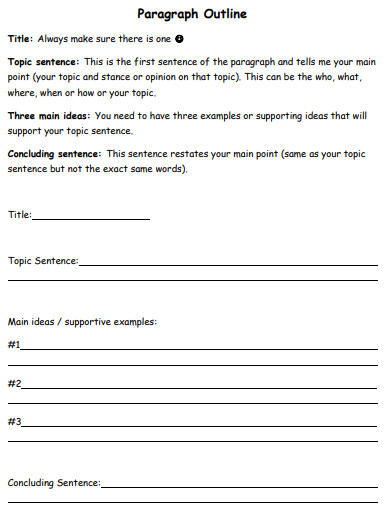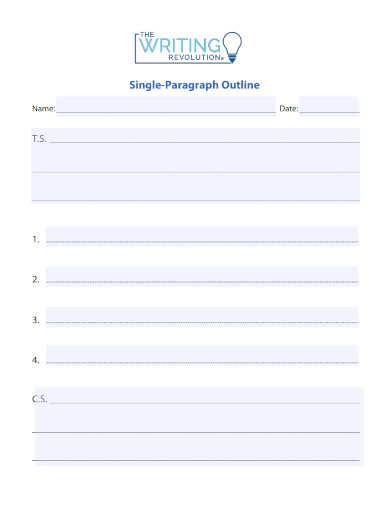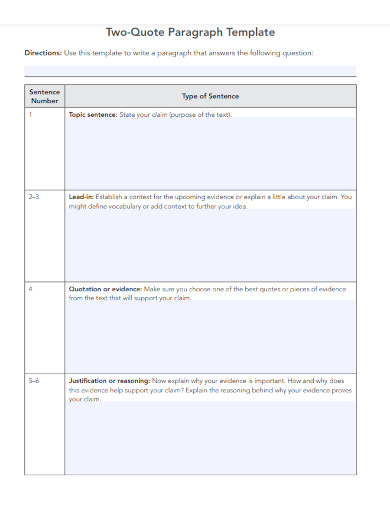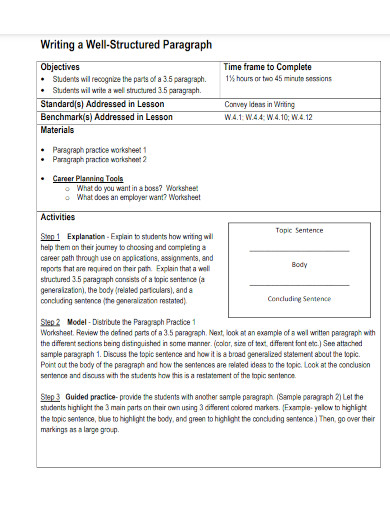As a reader, reading a book with a hundred pages with no breaks in between ideas, chapters, and dialogue between characters will be overwhelming for you. Writing includes dividing its parts into more manageable sections that are coherent to enable readers to take in and process the book’s content easier and faster. A paragraph is a part of a writing process that contains more than one sentence and is separated from other paragraphs and text by a space.
10+ Paragraph Samples
1. Paragraph Outline
2. Sample 5 Paragraph Essay
3. Body Paragraph Outline
3. Perfect Paragraph Template
4. Single-Paragraph Outline
5. Basic Essay Paragraph Format
6. Perfect Paragraph Format
7. Argumentative Paragraph Template
8. Petal Paragraph Template
9. Two-Quote Paragraph Template
10. Writing Well-Structured Paragraph
11. Thesis Paragraph Template
What is a Paragraph?
Paragraphs are components of a student paper, research paper, books, and other written and printed materials which consist of at least three to five sentences each. These series of sentences are logically arranged and are related to each other. During the essay writing process, paragraphs show the readers where the subdivisions of the essay start and end which enables them to easily grasp and understand the main points of the composition.
How to Create a Paragraph?
A paragraph can include various kinds of information, from providing a series of concise examples to a single and long explanation of a single point. It can be a description of a place, person, or method, a narration of a series of events, a comparison and contrast of a subject, and more. A paragraph aims to deliver the writer or speaker’s ideas on a certain topic in a comprehensive and clear manner that is only specific to that paragraph. Hence, paragraphs should not consist of mixed ideas or thoughts.
Step 1: Determine your Topic Sentence
Topic sentences are components of a paragraph that supports your thesis statement, connect the content of every paragraph, sets the direction of the sentences, and give the readers how the content will be discussed. It is written at the beginning of the paragraph to build an idea or scenario or continue the idea of the previous paragraph.
Step 2: Provide Supporting Details
The middle sentences in your paragraph contain the follow-up or supporting details to your topic sentence or the previous paragraph. These sentences aim to persuade the reader in believing or envisioning your ideas and provide them with evidence to visualize your arguments or points of view.
Step 3: Write Concluding Sentences
A concluding statement or sentence can be used in the last line of its own paragraph even if you are not ending your piece of writing yet. It states the conclusion of a certain idea or thought before proceeding to write the next paragraph.
Step 4: Use Transition Words
Using transition statements or words will help you connect together separate paragraphs to establish a coherent thought or idea. You can use phrases such as “In addition” or “moreover” to enable your readers in tracking and understanding your ideas and how they relate to one another. Transition words are most helpful when writing essays and blogs that focus on a single topic at a time.
FAQs
What are the characteristics of an effective paragraph?
Every paragraph should be unified in that all of its sentences should be relevant to a single idea, clearly related to its thesis statement, coherent and follows a definite development plan, and must be well-developed in which all ideas discussed in the paragraph are properly explained and supported.
How to organize a paragraph?
There are various ways to organize a paragraph and it usually depends on the main topic or idea it will be discussing. A paragraph can be a narration that chronologically tells a story, a description of a certain idea or object, a process that explains how something operates or functions, a classification of groups, and an illustration that explains supporting details.
What is the structure of a paragraph?
A paragraph has a three-part structure that includes the introduction which is the first section of the paragraph, the body which discusses the main idea using facts or data analysis, and the conclusion which summarizes the relationship between the details discussed in the body.
A paragraph is a group of sentences that covers a single topic that is organized in a logical manner, helping the readers to easily understand its content. It is used when writing a large piece of writing like novels, creative writing, stories, and other professional pieces of writing and divides its parts into smaller sections. Paragraphs include a topic sentence, supporting sentences with relevant information, and a closing statement or sentence.
Related Posts
FREE 10+ Sample Analysis Essay Templates in MS Word PDF
FREE 10+ Sample Rejection Letter Templates in PDF MS Word ...
FREE 7+ Sample Job Cover Letter Templates in MS Word PDF
FREE 8+ Sample Resignation Letter Templates in PDF MS Word
FREE 11+ Essay Samples in MS Word
FREE 6+ Sample Informative Essay Templates in MS Word PDF
FREE 7+ Sample Resume Cover Letter Templates in PDF MS Word
FREE 8+ Persuasive Writing Samples and Templates in PDF
FREE 7+ Sample Poetry's Analysis Templates in PDF MS Word
FREE 5+ Contractor Letter of Intent Samples in PDF MS Word
FREE 7+ Board Resolution Samples in PDF MS Word
FREE 8+ Sample Resume Outline Templates in PDF MS Word
FREE 6+ Sample Engineering Cover Letter Templates in PDF
FREE 9+ Sample Systems Analyst Job Descriptions in PDF
FREE 7+ Personal Essay Samples in PDF











